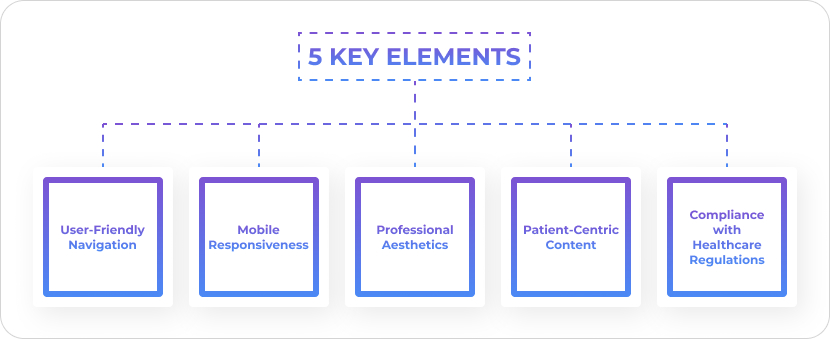Tips for creating a design for a medical website
- 15.05.2024
- 1 views
- 4 min
A well-designed website not only enhances your online presence
In today's digital age, having a professionally designed medical website is crucial for any healthcare provider. Patients increasingly rely on the internet to find healthcare services, seek medical advice, and make informed decisions about their health. A well-designed website not only enhances your online presence but also builds trust and credibility with your audience.
Creating an effective medical website goes beyond aesthetics. It involves a careful balance of user-friendly navigation, informative content, and compliance with healthcare regulations. Whether you are a small clinic or a large hospital, your website should reflect your commitment to quality care and patient satisfaction. In this article, we will explore key elements and best practices to help you design a medical website that meets the needs of your patients and stands out in a competitive digital landscape.
What to Consider When Creating a Medical Design
Creating a medical website involves careful planning and consideration to ensure it meets the needs of your patients while reflecting the professionalism of your practice. Here are five key elements to focus on when designing your medical website:

-
User-Friendly Navigation
Ensure your website is easy to navigate with a clear and intuitive menu structure. Visitors should be able to find information quickly and effortlessly. Include a search bar to further enhance usability. -
Mobile Responsiveness
Design your website to be fully functional on all devices, including smartphones and tablets. Given the increasing use of mobile devices, it's crucial that your site provides a seamless experience regardless of screen size. Test your site on various devices to ensure consistency. -
Professional Aesthetics
Use a clean, modern design that reflects the professionalism of your medical practice. Consistent use of brand colors, fonts, and logos helps establish a cohesive and trustworthy image. Visual appeal can significantly impact a patient’s first impression of your practice. -
Patient-Centric Content
Provide clear, accessible information about services, procedures, and healthcare topics. Use simple language and avoid medical jargon to make the content understandable for all visitors. Including FAQs, blog posts, and patient testimonials can help engage and inform your audience. -
Compliance with Healthcare Regulations
Ensure your website adheres to HIPAA (Health Insurance Portability and Accountability Act) and other relevant regulations to protect patient privacy. Clearly display your privacy policy and terms of service. Proper compliance not only protects your practice but also builds trust with your patients.
What to avoid while creating a design
When designing a medical website, it’s crucial to steer clear of certain common mistakes that can negatively impact user experience and the overall effectiveness of the site. Here are some key pitfalls to avoid:
- Complex Navigation
Avoid creating a complicated navigation structure. Users should be able to find what they are looking for within a few clicks. Complex menus and hidden links can frustrate visitors and cause them to leave your site.
- Outdated Design
Do not use outdated design elements. An old-fashioned website can make your practice appear out of touch with current technology. Regularly update your website's design and content to maintain a modern, professional image and meet evolving patient expectations.
- Excessive Use of Pop-Ups
Avoid bombarding users with too many pop-ups and ads. While some pop-ups can be useful, excessive interruptions can annoy visitors and lead to a poor user experience. Use pop-ups sparingly and ensure they are relevant. erience. Use pop-ups sparingly and ensure they are relevant.
- Lack of Clear Call-to-Action (CTA)
Do not forget to include clear and compelling calls-to-action. Visitors should always know what steps to take next, whether it's scheduling an appointment, signing up for a newsletter, or contacting your office. Make your CTAs prominent and easy to follow.
- Ignoring Analytics
Avoid neglecting the use of website analytics. Without tracking and analyzing user behavior, you won’t know what’s working and what’s not. Use tools like Google Analytics to gather insights and continuously improve your website's performance.
Format Suitable
When designing the layout of your medical website, consider the following key elements to include and demonstrate in the design.

Clear Navigation: Ensure that the navigation menu is prominently displayed and easy to use. Include links to essential pages such as services, about us, contact, and patient resources. Utilize dropdown menus for additional organization if necessary.
Concise Content Sections: Break up content into digestible sections using headings and subheadings. Provide clear and concise information about your services, specialties, and expertise. Use bullet points or numbered lists to highlight key points and make the content easier to scan.
Visual Hierarchy: Establish a visual hierarchy to guide users' attention to the most important elements on each page. Use larger font sizes, bold text, and contrasting colors to emphasize headings, subheadings, and calls-to-action.
High-Quality Imagery: Incorporate high-resolution images that align with the theme and message of your practice. Use professional photos of your facilities, staff, and patients to convey authenticity and build trust. Opt for images that evoke positive emotions and resonate with your target audience.
Responsive Design: Ensure that your website is optimized for viewing on various devices, including desktops, laptops, tablets, and smartphones. Use a responsive design approach to adapt the layout and content dynamically based on the screen size and orientation, providing a seamless browsing experience across devices.
Consistent Branding: Maintain consistency in branding elements such as colors, fonts, and logo placement throughout the website. This helps reinforce brand identity and makes your website more memorable to visitors. Use your brand colors strategically to draw attention to important elements and create visual cohesion.
Accessibility Features: Make your website accessible to users with disabilities by incorporating features such as alternative text for images, keyboard navigation, and resizable text. Ensure that all users, regardless of their abilities, can navigate and interact with your website effectively.
Contact Information and Calls-to-Action: Display your contact information prominently on every page, including phone numbers, email addresses, and physical addresses. Incorporate clear calls-to-action (CTAs) throughout the website to encourage visitors to take the desired actions, such as scheduling an appointment or contacting your office.
By incorporating these elements into your website design, you can create a user-friendly and visually appealing experience that effectively communicates your practice's offerings and values to potential patients.
Conclusion
Designing a successful medical website requires careful attention to detail and a focus on creating a user-friendly experience for visitors. By incorporating elements such as clear navigation, concise content, high-quality imagery, and responsive design, you can effectively showcase your practice's offerings and values. Consistent branding and accessibility features further enhance the website's appeal and usability. Remember to regularly monitor website analytics and gather feedback from users to make continuous improvements. With a well-designed website, you can not only attract new patients but also build trust and credibility with your existing ones. Invest time and effort into creating a professional and engaging online presence, and reap the rewards of a thriving digital presence for your medical practice.









